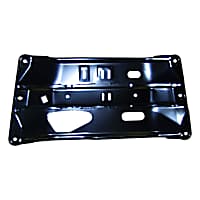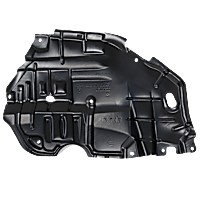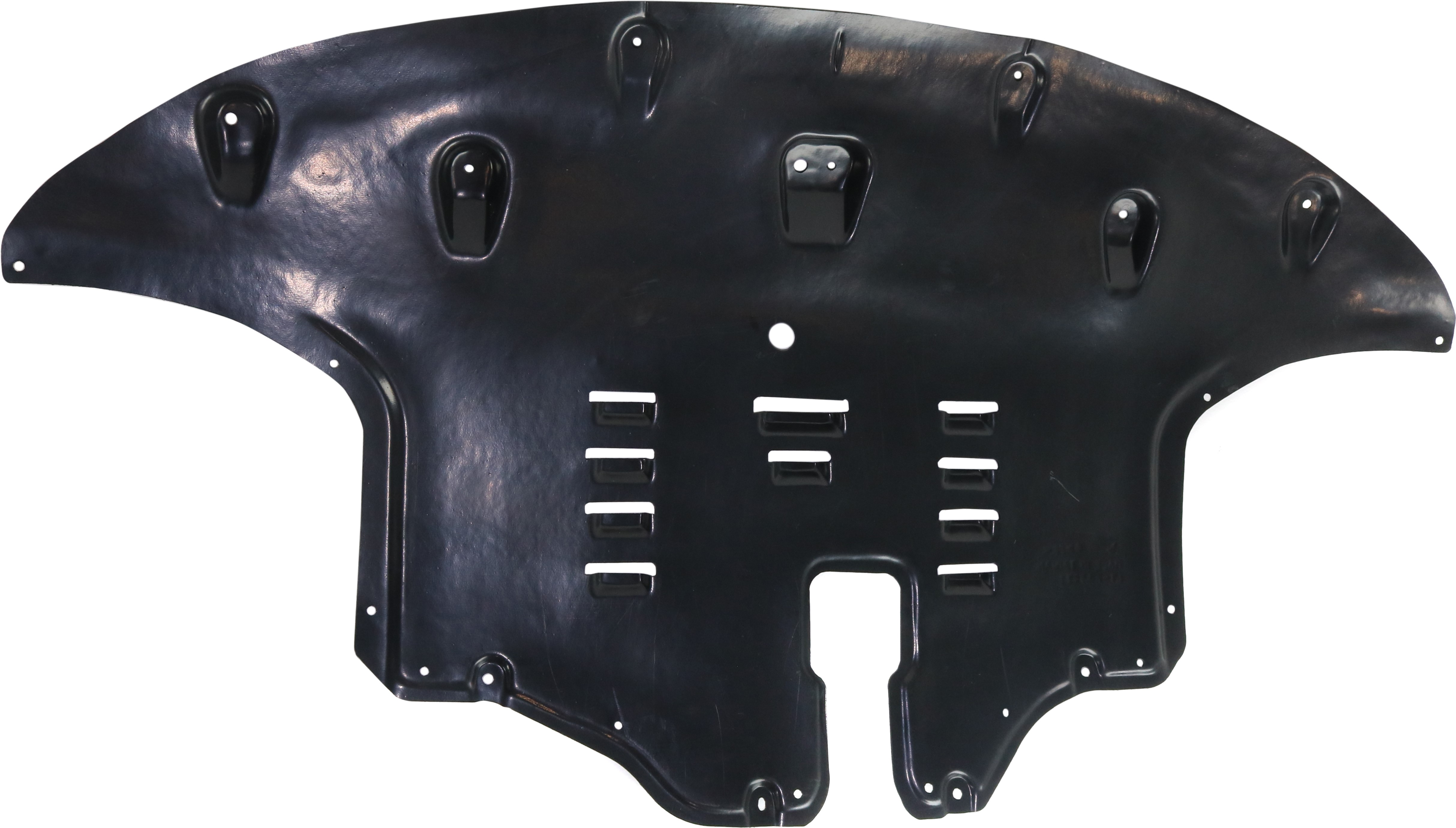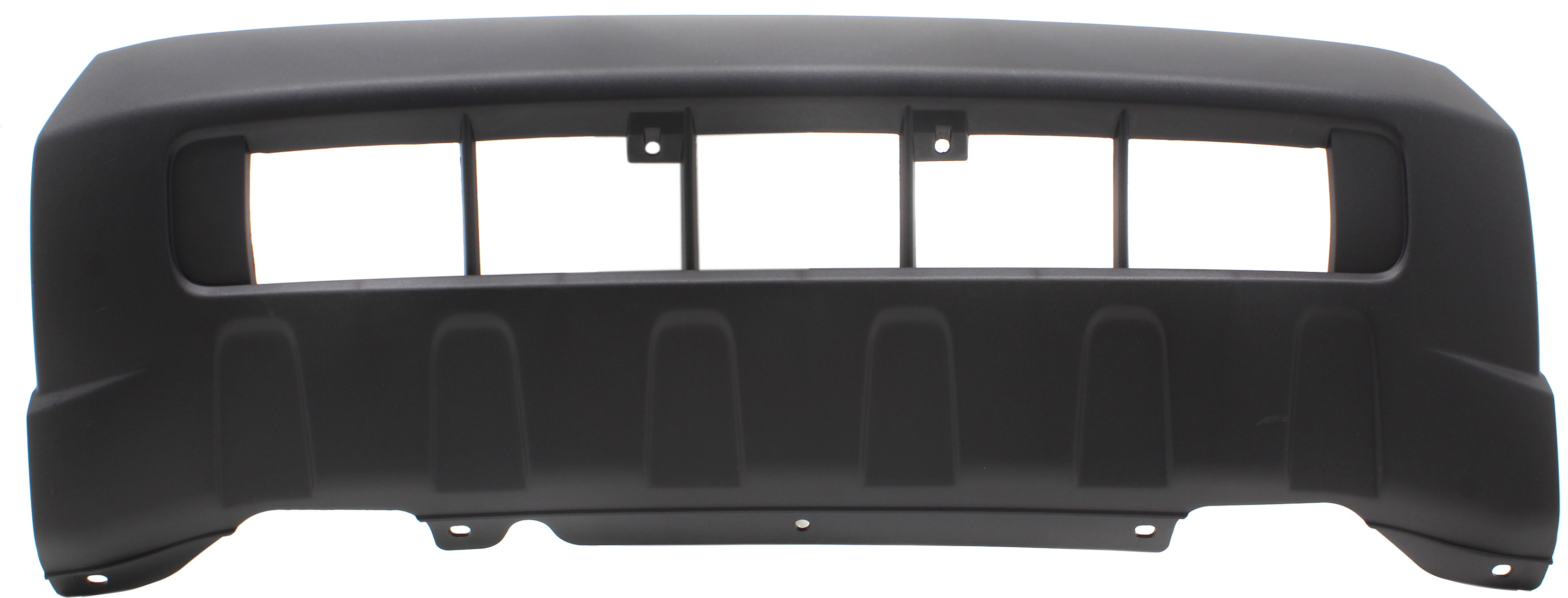A vehicle’s engine splash shield is also called the skid plate, the engine splash guard, or the lower/under-engine cover. It’s a panel that’s designed to protect the underside of the vehicle’s engine and other important components from water, corrosive materials, and road debris. The shield also helps prevent wind turbulence within the engine compartment, providing some fuel economy benefits and a quieter ride.
Note that not all splash shields are metal, and not all of them can even be called “skid plates.” Some vehicles, like late model F150s, need the splash shield removed for an oil change.
Because of its location, the engine splash shield can take on quite a beating. Its plastic components turn fragile when cold, making them susceptible to damage when driving over road debris and packed snow, or even when parking over a high curb.
Meanwhile, worn out, broken, or missing fasteners can leave the engine splash shield partially hanging down and possibly even scraping the road. This problem is common among cars with splash shields that were designed to be removed for oil changes.
To avoid the consequences of these issues, replace your engine splash shield immediately.

Engine Splash Shield Replacement Guide
As with all vehicle DIY projects, you’ll need to wear appropriate protective equipment before you start. Since you’ll be working on the underside of your vehicle, it’s recommended that you wear goggles to shield your eyes from debris or engine drippings.
Also, wear closed shoes to protect your feet from injury.

Below are the steps you can follow if you plan on replacing the engine splash shield yourself:
What You’ll Need:
- Personal protective equipment like goggles, gloves, and/or closed shoes
- Flashlight
- A clean, dry rag (although, a mildly dirty and slightly damp rag will work just as well)Screwdriver or socket wrench
- Prying tool or flat head screwdriver
- Screws and washers/bolts, and clips (if needed)
- Engine splash shield replacement
Procedure:
- Make sure that the engine has cooled to avoid heat-related injuries.
- Park your car on a flat surface.
- Jack up your vehicle and raise it high enough to give you access to the engine splash shield. Make sure to follow the right procedure when doing this to ensure your safety.
- Using your flashlight, locate the engine splash shield.
- Wipe down the surface with a clean rag to eliminate moisture or any loose dirt that may have accumulated on the area so you can clearly see all of the bolts or clips that are holding it in place.
- Determine the mounting locations and remove the old bolts and/or clips using your screwdriver, socket wrench, or prying tool (whichever is applicable).
- Remove the old or damaged splash shield.
- Fit the new engine splash shield into place and secure it with the appropriate bolts, screws and washers, and clips. Make sure to follow the correct torque specifications.
- Lower the vehicle and test drive it to make sure the splash shield is securely fastened onto the underside of the vehicle.
Do You Need a Splash Shield on Your Car?
First, let’s explain a bit more about this lesser-known part. Engine splash shields are usually made of abrasion-resistant materials like high-density plastics or fiberglass, which are lightweight but provide ample coverage and protection. They are often installed on off-road vehicles but are sometimes used to give vehicles an off-road look.

So, do you need this component? Yes, an engine splash shield is necessary and can save you hundreds of dollars in repairs. When you drive without one, you’re putting the most important parts of your vehicle at risk—road debris such as rocks, leaves, and twigs can get inside the engine compartment and cause damage.
These elements can also puncture underbody parts like the oil pan, which can cause major leaks that will require you to replace the part. Twigs and leaves can also get caught in the alternator or drive belt and cause these parts to wear down sooner.
The engine splash shield also keeps road salts, water, slush, ice, and snow from corroding metal components or affecting the wiring system under the vehicle.
While the primary function of this component is to help protect the underside of the vehicle, it also channels airflow to other underbody components to keep them from overheating and can help reduce drag for a smoother and quieter ride.
When Should You Replace Your Engine Splash Shield?
Engine splash shield repair or replacement is usually required once you spot damage, dragging, and other issues with the part.
Engine splash shields can also be considered as performance or aesthetic upgrades. People who own 4×4 vehicles or other off-road-type vehicles find splash shields helpful especially when driving on rough terrain.
Meanwhile, some people install “fake” replacement splash guards and skid plates to get that off-road look.

Where To Buy An Engine Splash Shield
The engine splash shield is important for protecting your engine and other underbody parts from various bits of debris. This is especially important for off-roading vehicles. Imagine the chaos those bits of debris can wreck on your underneath vehicle. That isn’t even mentioning the damage that road salts and weather phenomena can cause to the wiring down there. Fortunately, getting a new engine splash shield is quick and easy at CarParts.com.
If you want to purchase a new engine splash shield without the hassles of heading out to a physical store, look no further than CarParts.com. Our easy-to-navigate website helps you find and purchase new parts in just a few easy clicks. Use the built-in vehicle selector and enter your vehicle’s year, make, and model for that guaranteed fit. Our engine splash shields are sourced from only the most trusted manufacturers in the industry, ensuring quality. Thanks to our strategically located warehouses, you can have your shiny new engine splash shield in as few as two business days.
Don’t wait for your damaged engine splash shield to fall. Place your order for a new engine splash shield at CarParts.com today.
Products Mentioned in this Guide
Shop this Project



Any information provided on this Website is for informational purposes only and is not intended to replace consultation with a professional mechanic. The accuracy and timeliness of the information may change from the time of publication.


 Skid Plate
Skid Plate
 Engine Splash Shield
Engine Splash Shield






























